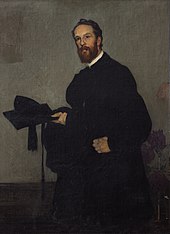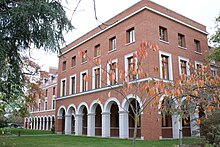Selwyn College, Cambridge
The college's first Master, Arthur Lyttelton, was formally elected on 10 March 1879, the Archbishop of Canterbury Archibald Tait was invited to become Visitor on 28 June 1878 and building of Old Court, as it is now known, began in 1880.
A Charter of Incorporation was granted by Queen Victoria on 13 September 1882, and the west range of Old Court was ready for use by the college's official opening (with the Master's installation) on 10 October 1882, in time for Michaelmas term.
He came from a well-established family with strong connections in both Church and State, his mother being the sister-in-law of the prime minister, William Ewart Gladstone, who became a major benefactor of the college.
The original foundation charter specified that the college should "make provision for those who intend to serve as missionaries overseas and ... educate the sons of clergymen".
An alternative site on Lensfield Road, where Our Lady and the English Martyrs Church now stands, was considered but rejected as too small.
There were originally plans to build a permanent library between F Staircase and the chapel to complete Old Court, on land that now forms part of the College Gardens, but this was not done.
In 1894 and 1896, respectively, the Old Library in the tower, received two extensive benefactions of history, politics and theological texts, from Canon William Cooke and Edward Wheatley-Balme.
Appleton's initials and rebus (three apples and a tun) appear on the north wall of the Hall entrance, and his posthumously painted portrait hangs in the college.
Undergraduates initially paid £27 per term for food, lodgings, lectures and tuition, with a small surcharge for students of medicine, scientists and engineers.
Old Court, construction of which began in 1880 and is built in Ketton stone and local red brick in the Victorian Late Perpendicular Gothic Revival style, was largely designed by Sir Arthur Blomfield and comprises seven staircases (A–G), together with a tower and gateway, Master's Lodge, Chapel, Hall, Kitchens, Music Practice Room and Archives.
Selwyn College Library is located adjacent to Old Court; it was designed by T. H. Lyon in 1929 to serve as a First World War memorial.
As a proponent of New Classical Architecture, Porphyrios designed new buildings which fit the existing limestone and brick materials of Selwyn College.
Ann's Court features hand-carved details and a series of limestone cloisters and chimneys arranged in the traditional Cambridge University fashion.
The second phase, including 40 en-suite bedrooms forming staircases Q and R and a new Junior Combination Room (JCR) at a cost of £2.5 million, was completed in Summer 2009.
The college plan calls for all future expansions to adhere to the same architectural style of limestone and brick demonstrated in the Ann's Court development.
This new wing of accommodation would enclose the western edge of Centre Court and would allow the college to increase graduate student numbers.
In 2018, the college assured concerned alumni and students that the original library would be preserved and converted into lecture and auditorium rooms (although the small 1970s annex will probably be removed).
Selwyn holds Formal Hall on every Tuesday and Thursday evening during Term at 7:30 pm with a capacity of 120, tickets for which can be bought by students for themselves and up to two guests.
The college Grace is recited in Latin by a Fellow or Scholar (a student who achieved a First Class mark overall in the previous year) at the beginning of Formal Hall, and is as follows: Benedic, Domine, nobis et donis Tuis, quae de Tua largitate sumus sumpturi; et concede ut iis muneribus Tuis ad laudem Tuam utamur, gratisque animis fruamur, per Jesum Christum Dominum nostrum.
Amen.When the High Table rises, the following concluding Grace is said Benedicamus Domino (Let us bless the Lord), with the response being Laus Deo (Praise be to God).
This tradition is not observed out of disrespect or irreverence for the sovereign, but rather, out of courtesy and remembrance of the former Master of the college, John Selwyn, who could not easily stand for the loyal toast owing to the limited use of his legs in later life.
[18] Lecturers have included many high-profile politicians, academics, and journalists including Onora O’Neill, Niall Ferguson, Michael Howard, Ian Kershaw, Roy Porter, Ian Clark, Lawrence Freedman, David Cannadine, Keith Thomas, Jonathan Riley-Smith and Quentin Skinner, former Regius Professor of Modern History.
[6] The college is visited by many members of the university who come from the neighbouring Sidgwick Site in-between lectures and supervisions to take advantage of Selwyn's Servery and Dining Hall.
[24] Like many Oxbridge colleges, Selwyn is reported to be home to secret societies and dining clubs including The Controversialists, The Cromwells, and The Templars.
The May Ball tradition at Selwyn began on 14 June 1948, as hundreds of students dressed in black tie to attend the all-night celebration.
Notable alumni of the Selwyn College Boat Club include Hugh Laurie, Tom Hollander and Richard Budgett.
In 2014, Selwyn, King's and Churchill colleges announced plans for a new, state-of-the-art combined boathouse located on the River Cam.
The boathouse features double-length beams and extensive gym and training facilities for all Selwyn College rowers and student athletes.
The two-storey combined boathouse is larger than its 1968 predecessor and provides facilities for socialising, training and boat maintenance in addition to an observation deck.
The combined boathouse was designed by RHP Architects at a cost of approximately £2.20 million and was the winner of the 2017 RIBA East Award for Outstanding Architecture.













